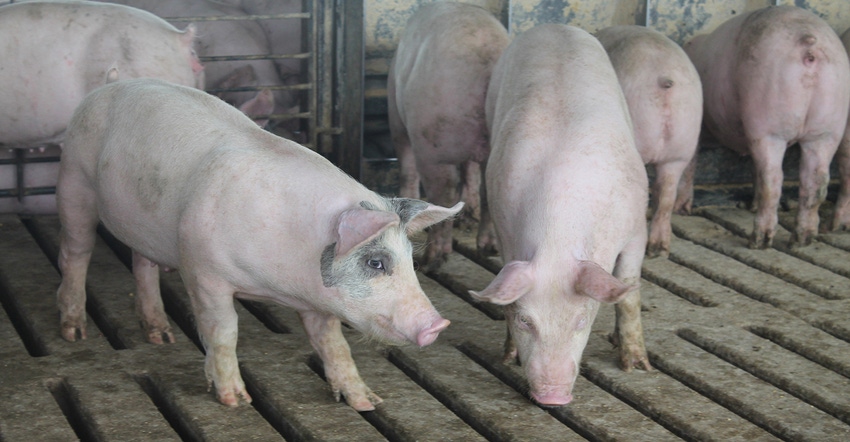Recombinant PCV2 adds new wrinkle to control programs.

Porcine circovirus has become a common virus in the global swine herd since first being described in 1974. In the late 1990s, a novel circovirus emerged in North America that was genetically distinct from what had simply been known as PCV. That existing PCV would become known as PCV Type 1, while the emerging virus would become PCV Type 2.
According to the Iowa State University College of Veterinary Medicine Veterinary Diagnostic and Production Animal Medicine Department, the emergence of PCV2 coincided with the occurrence of a new clinical syndrome of swine referred to as postweaning multisystemic wasting syndrome. Since its appearance, PCV2 (and PMWS) has become widely distributed in most developed swine industries around the world. The term PCVAD (porcine circovirus-associated disease) is now used in North America to refer to the different disease manifestations associated with PCV2.
Darin Madson, formerly with the ISU Veterinary Diagnostic Laboratory, said in a National Hog Farmer webinar on PCV2 that PCV2 started to surface in Canada in the early 1990s, but it wasn't truly defined until 1999. "That's when it was noted across North America as being associated with disease," Madson said in the webinar, which was sponsored by Merck Animal Health. "By 1999-2000, it was realized that PCV2 was associated with a disease process."
Madson went onto say that it wasn't until 2005-07 in the U.S., when the diagnostic labs showed high case-load years, "when it really took hold and caused a lot of problems." As PCV2 problems started to arise in the U.S., the situation also got pharmaceutical companies busy developing vaccines, "and we could get the number of cases under control at that point," he said.

Evolution of PCV2
The swine industry has seen viruses evolve over time, and PCV2 is no exception. So far variants PCV2 a, b, c, d, e and f have been identified.
Meggan Bandrick alerts the hog industry to now be aware of PCV2 throwing yet another wrench into the swine health care picture. The associate director of global biologics research for Zoetis feels the extent of PCV2 recombination in the field is not fully understood.
"Recombination is the exchange of genetic material between organisms — in this case, viruses — that are infecting the same cell. For PCV2, recombination can occur between related or very different PCV2 viruses. … Let's say they're PCV2a and PCV2b; then the recombinant virus, which would be the child of those two parents, would actually be a mixture of PCV2a and PCV2b. So that 'child' then would contain bits of Mom and bits of Dad," she said.
Problem with 2 PCV2 parents
So, what's the big concern about two PCV2 parents replicating and forming a new version of themselves within a single pig cell?
"Some of those recombinant viruses will act similarly to the parent virus, and you wouldn't even know that there is a recombinant virus present," she said. "The recombinant virus could result in the same sort of clinical signs that you would see as that parent. So, in effect they would be very much the same, and they wouldn't cause any different problems."
Of course, there has to be a "but."
"But, in some cases, those recombinants actually are quite different than either one of their parents. So, having one part of the genome from one parent and the other part of the genome from the other parent can actually make that recombinant virus more fit, or better at replicating, or better at causing disease or better at escaping the immune response," she said.
"If you think about vaccination — if you're vaccinating to protect against one of the parent viruses, and if the child virus has inherited part of a different virus, that gives it a leg up over its parents. That leg up might make it better able to escape the immune response."
It is this ability to escape the immune response that worries Bandrick the most.
Recombination nothing new
Recombination is nothing new in the virus world, as porcine reproductive and respiratory syndrome virus and many other viruses have shown the ability to recombine, but not all viruses do recombine. Bandrick says influenza, for example, because of its different type of genome, "doesn't really recombine, but it shares a genetic sequence in a different way. And that's reassortment."
Recombination is not a new phenomenon for PCV2, as Bandrick said it has been occurring for some time. "It's been in pigs for a long time; and, in fact, the majority of pigs are vaccinated against PCV2." Though vaccines have been effective against PCV2, Bandrick said the fact that the virus strains are still present on hog farms may be partially attributable to recombinant viruses.
She said research findings show that about 30% of PCV2 viruses are recombinants, "and we know that some recombinant viruses can cause disease."
"The problem is that it's difficult to identify recombinant viruses because you have to actually look at the genetic sequence. And that's really restricted to research right now," she said. "A producer, for example, has no way to tell if a virus is a recombinant or not. They might submit samples to a diagnostic lab, which might report finding a PCV2a or a PCV2b or a PCV2d, but the lab wouldn't be able to identify a recombinant virus."
Spreading awareness
Reports of recombinant viruses causing disease do exist, "and it's probable that we know about those cases because they were severe enough cases to be written up and published. While it's important to know that they were recombinant viruses, we just don't have enough information to know whether all of the cases of PCV2 disease are caused by recombinants or not," she said.
Though veterinarians and producers are aware that recombination does occur, she said most of the work on recombinants is currently on the academic level.
"Surely, veterinarians and producers likely are aware that recombination happens for PRRS. And surely we know that reassortment, but not recombination, happens for flu. But in terms of PCV2, I think that it's really not fully realized that PCV2 can recombine, and it's not fully realized how diverse PCV2 actually is, and what the evolutionary rate of PCV2 actually is.
"And I would say that the evolutionary rate of PCV2 is actually higher than, really, we ever thought it would be."
For this reason, Bandrick said there is more variability in PCV2 viruses than has been thought. "One reason is, it has a really high mutation rate. But then the other reason we see all of that variability is because of this ability for PCV2 to recombine." PCV2 a, b and d are the most prevalent PCV2 types found; thus, most of the recombinants being seen are combinations of a, b and d.
Know your PCV2 virus
Bandrick said producers and their herd veterinarians should know which PCV2 virus is circulating on-farm — whether it's a, b or d, "and also evaluate the age affected and the types of clinical signs that you're seeing, so that you can go back and look at your vaccination program.
"If you're having issues that you're not able to control, it may be worth some additional sequencing. If sequencing reveals you have more than one type of PCV2, you likely have recombinant viruses as well."
Regardless, if a farm has recombinant virus activity, Bandrick said the best preparation is through a vaccination program.
"The best way to be prepared for PCV2 and for the genetic changes that we know will come is to vaccinate. Vaccinate with something that gives you the broadest coverage against the variability that we see in PCV2.
"So, something that educates the immune system, such that the pig could be protected against a variety of PCV2s. And, use a vaccine that lets fewer PCV2 viruses escape the immune response."
About the Author(s)
You May Also Like



